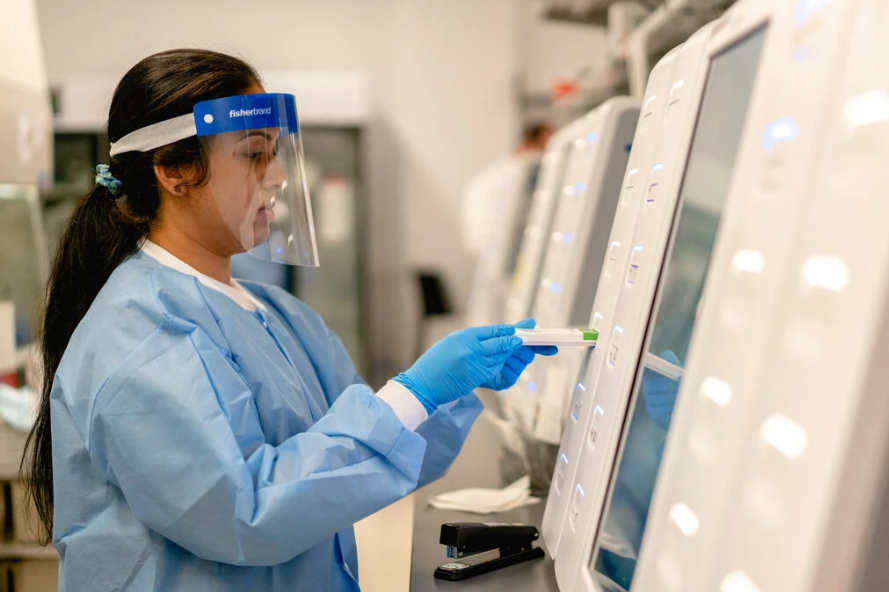
Is COVID-19 PCR Testing Too Sensitive?
The CDC has come under fire recently for updating their guidelines suggesting that not everyone who has been exposed to someone with COVID-19 needs to be tested, especially if they have no symptoms. You can read about that here. This does seem illogical, surely more testing is always a good thing? Perhaps not in the current context. The CDC didn't articulate their point very well, but perhaps what they meant, is akin to what experts are now saying. Based on how PCR testing works, experts are cautioning that there may be huge swaths of people being diagnosed with COVID-19 who are carrying relatively insignificant amounts of the virus, as reported by the NY Times.
Let's talk about how PCR testing currently works. First, all it does is give you a positive or negative result, even though there is other pertinent information that is available from the test results. Yet, whether your are symptomatic or whether you are contagious depends on what your viral load is. Viral load is defined as "a measurement of the amount of a virus in an organism, typically in the bloodstream, usually stated in virus particles per millilitre". Basically, the more of the virus you have in you, the more likely you are to have symptoms and be contagious. This is why the concept of "Transmission = Time + Exposure" exists and is very important. It's why you are very unlikely to contract COVID-19 whilst wandering around a grocery store, even if you pass by several people who are positive for the virus. Chances are, they have a low viral load which is why they are out and about because they are asymptomatic. So your exposure is low and you aren't around them for long enough to contract enough viral load to get sick yourself. Even contract tracing apps typically don't warn you of exposure unless you have been confirmed as being in range (within 6 feet) of someone for at least 15 minutes who tested positive. These implications are important as, based on the current PCR testing methods, it's possible, even likely, to test positive for COVID-19 even if your viral loads are so low, you would never be sick or able to transmit the virus to anyone else.
The PCR test amplifies genetic matter from the virus in cycles; the fewer cycles required, the greater the amount of virus, or viral load, in the sample. The greater the viral load, the more likely the patient is to be contagious. This number of amplification cycles needed to find the virus, called the cycle threshold, is never included in the results sent to doctors and coronavirus patients, although it could tell them how infectious the patients are. In three sets of testing data that include cycle thresholds, compiled by officials in Massachusetts, New York and Nevada, up to 90 percent of people testing positive carried barely any virus, a review by The Times found.
If the cycle thresholds in Massachusetts, New York and Nevada are valid nationwide, the implications are significant. It would mean that of the roughly 45000 positive PCR test in the United States on Thursday, only around 4500 people should actually be required to submit to contact tracing and self isolate as the rest have so little viral load, they would not be contagious.
One solution would be to adjust the cycle threshold used now to decide that a patient is infected. Most tests set the limit at 40, a few at 37. This means that you are positive for the coronavirus if the test process required up to 40 cycles, or 37, to detect the virus. Tests with thresholds so high may detect not just live virus but also genetic fragments, leftovers from infection that pose no particular risk — akin to finding a hair in a room long after a person has left, Dr. Mina said. Any test with a cycle threshold above 35 is too sensitive, agreed Juliet Morrison, a virologist at the University of California, Riverside. “I’m shocked that people would think that 40 could represent a positive,” she said.


Dr. Mina said that she would set the cycle threshold at 30, or even less. Reducing the threshold from 40 to 30 would mean the amount of genetic material in a patient’s sample would have to be 100-fold to 1,000-fold lower than that of the current standard for the test to return a positive result. The CDC themselves suggested that is it extremely difficult to detect any live virus in a sample above a threshold of 33 cycles.
Officials at the Wadsworth Center, New York’s state lab, have access to C.T. values from tests they have processed, and analyzed their numbers at The Times’s request. In July, the lab identified 794 positive tests, based on a threshold of 40 cycles. With a cutoff of 35, about half of those tests would no longer qualify as positive. About 70 percent would no longer be judged positive if the cycles were limited to 30. In Massachusetts, from 85 to 90 percent of people who tested positive in July with a cycle threshold of 40 would have been deemed negative if the threshold were 30 cycles, Dr. Mina said. “I would say that none of those people should be contact-traced, not one,” he said.
The FDA did point out that if you reduce the threshold, you may miss newly infected patients as their viral load be initially be low. This is likely more a concern in the US, where testing is typically done much more quickly than other parts of the world. Regardless, a valid point, though Dr. Mina points out this issue is easily mitigated. “Test them again, six hours later or 15 hours later or whatever,” he said. A rapid test would find these patients quickly, even if it were less sensitive, because their viral loads would quickly rise."
Highly sensitive PCR tests seemed like the best option for tracking the coronavirus at the start of the pandemic. But for the outbreaks raging now, he said, what’s needed are coronavirus tests that are fast, cheap and abundant enough to frequently test everyone who needs it — even if the tests are less sensitive. “It might not catch every last one of the transmitting people, but it sure will catch the most transmissible people, including the superspreaders,” Dr. Mina said. “That alone would drive epidemics practically to zero.”
Ultimately, PCR testing only test a patient at a single point in time, is cumbersome and takes quite some time to get tested and then get results back, especially here in the Atlantic provinces. I do want to note, that I have no knowledge or information around the specific criteria or cycle threshold used in Canada or Nova Scotia. It may be the same as the US (37-40) or it may be more or less. It's certainly a question that would be helpful to know the answer to. It's quite interesting to know that the nature of PCR testing in general has such a wide range of criteria to produce a positive result. For example, someone who test positive after just a couple of cycles is someone who is likely ill and very contagious, vs someone who test positive on cycle 38 who is likely not ill and not at all contagious. Yet we simply see both as a positive COVID-19 case and the protocols for each individual are the same as far as contact tracing and isolation requirements.
Given that COVID-19 is quite likely to be here for the long haul, these nuances are very important to both understand and act on. Utilizing this type of data to formulate common sense policy is what 'living with the virus" actually means. Currently, that phrase is thrown around a lot but what I see in action is actually not allowing us to live with the virus at all but continuing with significant restrictions that as of now, have to end in sight. If we reduced the PCR cycle threshold, or even better, left it as is but included it in the results, it could be a real game changer. Hear me out. What if we leave the threshold at 40 so we're capturing as much information as possible, but we have different protocols based on the results, For example, anyone who tests positive within 20 cycles is classed as contagious and must self isolate and submit to contact tracing. If a positive test occurs between 20-30 cycles then the person is required to have a 2nd test to see if their viral load changes. If a positive test occurs beyond 30 cycles, then no action is required. The caveat could be that if it cannot be confirmed when/who/where a person with a cycle threshold over 30 may have contracted the virus, then they also require a 2nd test just to be sure they didn't just contract it and will later develop a higher viral load. We could then easily track this information over time and it may come to light that those who test positive with a cycle threshold over 20 may only break the 20 threshold after a subsequent test in so few cases that we would even drop their requirement for a 2nd test, or the opposite may be true and the threshold criteria may be adjusted up from 20 to 30.
This is just an off the cuff example, but it illustrates how we could use a far more nuanced approach, with data that already exists, so manage the pandemic in a much more detailed, individual way rather than these high level blanket approaches that don't allows us to live with the virus in any meaningful way. As an aside, I wonder how many deaths linked to COVID-19 have occurred because someone tested positive with a threshold well over 30. That would also be VERY interesting to know as in those cases, it's quite likely that COVID-19 isn't what killed them at all. We know these cases exist but have no real concept of how pervasive it is. For example, in Canada we have over 9000 deaths linked to COVID-19, but the goal would be to really understand how many of those people would have still died when they did, regardless of COVID-19? Is it 100, 1000, 5000, 8000, 9000? No one seems to know, yet this data could probably shed a significant amount of light on that. The CDC in the US recognizes that just 6% of all COVID-19 deaths in the US had no co-morbidities. As in, the patient had no underlying conditions and the only known source of death was COVID-19. In the remaining 94% of deaths, patients had an average of 2.6 additional underlying conditions, most frequent being Influenza/Pnemonia, Hypertension, Diabetes, Vascular Dementia, Renal (Kidney) Failure, Chronic Lower Respiratory Disease, Ischemic Heart Disease, Cardiac Arrest, Sepsis.
Better usage of data we already have available plus the incorporation of rapid (s, of Saliva) testing (of which the US recently ordered 150M testing kits) could really change the scope of how we look at COVID-19, how we react to new cases and we can can learn to live with the virus for the long term, without requiring so many sacrifices we are forced into accepting reality as a "new normal".
